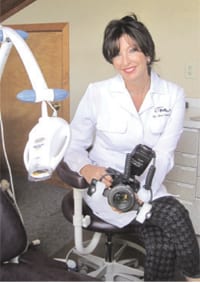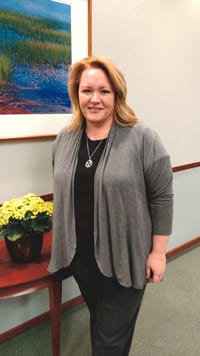Compounding the Issue The Art and Science of Concocting Pharmaceutical Solutions
Amy Barden has what many would consider a unique job.
As a certified pharmacy technician at Louis & Clark pharmacy on Birnie Ave. in Springfield, she’s also certified in basic, sterile, and veterinary compounding. “When people ask what I do, I tell them, and they have absolutely no idea what it means,” she told HCN before doing what she does for those inquirers — some explaining.
What she does, besides assisting pharmacy Manager Stasia Wojcik, with filling prescriptions, is prepare customized prescription drugs for customers — some human, some feline and canine. Think of the old-fashioned apothecary, grinding herbs and powders with a mortar and pestle.
Well, it’s not actually herbs straight out of a garden, and she mixes the prescriptions in a licensed and strictly regulated sterile environment, but the concept is pretty much the same as what apothecaries did centuries ago. However, the general public — and, surprisingly, many doctors, according to Wojcik — consider the little-known skill of compounding to be a bit scary.
But this is mostly just fear of the unknown.
“There are many doctors who are not aware of the variations that are available in drugs,” said Wojick. “They are educated in what the drug is and how it works, but not in the variety; we deal with all of the different types of medications and how it can come down to just one person.”
Clark “Skip” Matthews, president of Louis & Clark, agreed, and noted that current knowledge of compounding, or lack thereof, is due to the nature of the disciplines.
“There are so many things doctors have to learn about so many drugs and prescribing for so many illnesses, where a pharmacist spends six years learning every single thing about each drug and its variables,” he explained. “A pharmacist doesn’t know nearly as much as the doctor, but … the collaboration with doctor, pharmacist, and patient is where you find the solution.”
The act of compounding, which is more readily accepted in Europe, according to Barden, and is becoming more popular in pharmacies around the nation, involves the customized preparation of a medicine that is not otherwise commercially available. Consider the fact that large pharmaceutical companies prepare mass quantities of drugs in various forms — pills, capsules, liquids, ointments, suppositories, lozenges, etc. — but, due to the necessity of keeping costs down and profits up, don’t customize every single drug. And often, there is a need for customization.
“Some patients just can’t take pills, for instance, like the elderly or children,” Wojcik said. “Some have trouble with that form of the drug, and in order to give them a form that they can take, we have to make it.”
Consider also that patients have allergies to dyes in the capsules or flavors in syrups, and if they’re mass-produced, there is no option for a dye-free or flavor-free version; it’s just cost-prohibitive, added Wojcik.
The medications are first prescribed by a physician, veterinarian, or other prescribing practitioner, and then compounded by a state-licensed pharmacist or certified technician, which, in the case of Louis & Clark, is Wojick and Barden. Wojick is certified for pharmaceutical — also known as basic or contemporary — compounding, and Barden is certified for basic, sterile, and veterinary compounding (more on those later).
And while the act of compounding in today’s pharmacies is generally an unknown commodity to those who casually drop off a prescription to the local drugstore, the International Academy of Compounding Pharmacists (IACP), an association representing more than 2,700 pharmacists, technicians, students, and members of the compounding community, reports that almost all hospital pharmacies compound medications. Meanwhile, 76{06cf2b9696b159f874511d23dbc893eb1ac83014175ed30550cfff22781411e5} of independent pharmacists now compound, and the overall compounding industry makes up an estimated 1{06cf2b9696b159f874511d23dbc893eb1ac83014175ed30550cfff22781411e5} to 3{06cf2b9696b159f874511d23dbc893eb1ac83014175ed30550cfff22781411e5} of the $300 billion U.S. prescription market.
For this issue and its focus on the pharmaceutical industry, HCN looks beyond those numbers and explains why they are on the rise.
Back in the Day
According to the American Institute of the History of Pharmacy (AIHP), a nonprofit national organization devoted to advancing knowledge and understanding of the place of pharmacy in history, compounding is actually the ancient origin of today’s drugstore.
Cave drawings detail the earliest history of humans using plants to alleviate pain and heal wounds. Poisonous and ineffective plants and minerals were identified, but so were those that showed promise in curing various disorders. While the Greeks are largely credited with the first truly scientific approaches to creating remedies, the first chemical experimentation occurred in Egypt, China, and Mesopotamia; the melding of Greek beliefs and methodology with the processes used by these other cultures is what helped facilitate modern pharmaceutical compounding.
Fast-forward to the Industrial Revolution, and pharmaceutical compounding was changed forever. As medications were being produced in mass quantities with machinery, and drug companies eventually became ultra-high-profit corporations, the ability for the patient to see elemental changes in their prescribed medications became something of the past. But as patients’ complaints and outreach to pharmacists increased, so did the act of compounding.
Indeed, hospital pharmacies were the first to compound on a regular basis in modern times, and the independents have followed suit. This gave rise to national standards to accredit pharmacies, which were already licensed and strictly regulated by state boards of pharmacy and the U.S. Pharmacopeia (USP).
Locally, Louis & Clark — founded in 1965 by Louis Demosthenous and Clark Matthews, Skip’s father — has seen steady growth over the years and now provides a professional pharmacy, compounding, facility services, medical equipment, independent-living services, and healthcare programs.
Wojcik describes compounding as an art, and, incidentally, the AIHP refers to early apothecaries as ’drug artisans.’ Barden goes one step further and compares the act of compounding to baking.
“A finished product, like a capsule, can only look one way, no matter who creates it, but two people can make a cream or an ointment, and they won’t look the same,” she said, calling this “pharmaceutical elegance.”
But this elegance is of no importance to the patient who is in pain or not getting the relief he or she needs from their one-size-fits-all prescription. What Barden does is personalize dosages due to age or physical size, such as pediatric or elderly patients, and she can also recreate a prescription that does not have an ingredient that might cause an allergic reaction. But for the comfort of the patient, she can also recreate the prescription in another strength or form, such as topical creams instead of pills or pills instead of liquids.
Flavors are also helpful, especially for children, who may not like the taste of a medication or may have chronic diseases that require them to take medications often, said Wojcik.
She can mix basic prescriptions, but Barden’s certification in veterinary and sterile compounding allows her to mix prescriptions for more complex patient needs.
Veterinary compounding for domestic animals is based on size, species, and administration form, while sterile compounding allows her to create prescriptions in the state-of-the-art clean room for injectables (aqueous and oil vehicles), inhalation solutions, ophthalmics (such as eye drops and ointments), intravenous antibiotics, and more.
“It’s really gotten more popular,” said Barden of the practice of compounding. “I think doctors are more into experimenting and trying different things, because whatever they’re using for their patients just isn’t working in some cases, and they’re willing to try combining different drugs together — and they weren’t doing that before.”
Neither, until recently, was insurance coverage available for compounding, she said.
“It’s an advantage and a disadvantage,” she explained. “When they [insurance companies] weren’t paying for it, the patient was paying out-of-pocket, and there was a much better profit for us. Now that they are paying for it, more people are open to it.”
Barden added that the unfamiliarity of compounding — it’s not the scary ’concoction making’ that many customers, and even doctors, still believe it to be — is the reason for the insurance industry’s slow movement to cover prescription compounds, even though compounding is the root of today’s pharmacological industry.
But acceptance is turning into gratitude. Barden gave the example of a woman whose prescription from a doctor in Boston required a new ingredient every month, some that were foreign, even to Barden, which prompted numerous phone calls with the patient over several weeks. After months of phone interaction, the woman finally came in on the day HCN was in the store, just to personally meet Barden and thank her.
“People are really excited when they know we can help them and they feel like it’s a personal relationship,” she said, adding that what she does involves very personal relationship, and compounding is just one more form of customer service in the pharmacy industry.
“You need to have interaction with your customers because, first of all, they seek you out when they get a prescription from their doctor and go to a drugstore that says ’we can’t do this [compounding]’, and ’you have to go somewhere else,’” she explained. “So they’re looking for you.”
Healthy Outlook
As awareness of what compounding is becomes more familiar to the pubic, Barden sees a brighter future for practitioners of this art.
“I think the fear of it is going away,” she told HCN. “Doctors are more comfortable with it; there is so much more literature and so many more organizations associated with compounding.”
Wojick agrees and notes that the growing programs, organizations, and certifications are making more pharmacists aware that they can expand the skills they were trained to use to begin with.
And Matthews adds that the independents may lead the way.
“I think the larger picture is that pharmacists go to school for this and it’s what they’ve been trained to do, but if they go to a chain, they may not have the time to get into the [certification] process,” he said. “For the independents, we’re there to take care of the whole patient; we don’t just count pills and stick a label on it.”
Added Barden, “I think it’s a wonderful thing that something can be customized to fit a patient’s specific need, and it should definitely be an early option in treating somebody, not a last resort.”




Comments are closed.